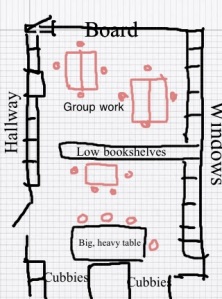So, I’ve been thinking about room arrangement all year. I started with a new format at the beginning of the year, changed it up a little based on some student input; then had the students plan and vote on a new arrangement. All that didn’t quite push the boundaries as much as I wanted. So, the last day of school before spring break after I dismissed everyone, I set to work. I dragged my husband in and we spent a couple of hours moving everything, and I mean everything, around.
First up, the student desks. They are a pain because there are enough of them that they can’t be rearranged quickly enough to be considered truly flexible. So they had to go. Well, ok they couldn’t entirely leave the room, but I did the next best thing. I lined then up facing the 2 long walls (window out and hallway). They are storage and independent work options, but not much else. Once we did that, I could really see some possibilities. I have a couple of low bookshelves that I dragged into the middle of the room. They now form a low wall bisecting the long rectangle space into 2 almost squares. Then I put my 2 nicer chairs in a good reading spot, found a semi-permanent place for the single biggest, and most significantly, heaviest table, and sprinkled my light easy to move IKEA tables liberally around the room. Voila!
Now we can have the IKEA tables pushed together for a big group discussion, in a U shape, in rows near the board if I need to show something there, or broken apart for pairs or groups of 4. I swear the room seems like it grew.

In some ways it looks more like a primary or preschool room now with the bookshelves dividing the space (although they only come up to the kids’ thighs at best). It has freed us up to work in groups without being on top of each other, and I feel like I finally really have the flexible learning space I have been craving all year.
I could go show about a million more variations to the room. Sometimes there are 2 main things going on, 1 in front, 1 in back. Sometimes people are all over: desks, tables, floor, cubby area. I thought I would just give an idea of some of the arrangement options. (I have to say I am better at furniture placement than photo placement on the blog here. But, I have spent enough time on this particular problem and need to move on-something we discuss a lot in 5th grade.)
So, I’m not sure why it took me six years to get here, I’m just glad I finally arrived.
(Pictures created with Doodle Buddy app)




